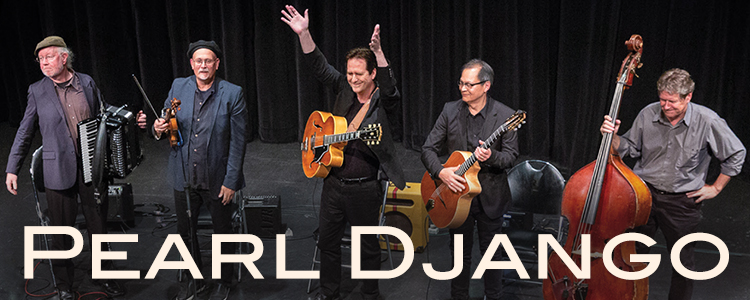
| REVIEWS |
|
Guitar Player Although the name Pearl Django seems tongue-in-cheek, guitarist Neil Andersson and company are serious about Gypsy swing. Originally a rocker, Northwest native Andersson found that jazz was his real love. “Playing Django-style guitar has totally renewed my interest in guitar playing,” he says. “It’s so intriguing to figure out how Django played, and how he developed his melodies. A lot of Django’s playing is classically influenced—such as his vibrato and his romantic approach to melody. It’s not just blues based.” The seeds of Pearl Django were sown when Andersson started playing standards with guitarist Dudley Hill. At a workshop in Vancouver (led by Britain’s Ian Cruickshank—a guitarist, author, and producer of the video Gypsy Guitar: The Legacy of Django Reinhardt), Andersson met an apprentice luthier, Shelley Park, who played some of the most authentic Gypsy rhythm guitar on the continent. Asking her to join the group was a given, and, after adding Rick Leppanen on bass and Michael Gray on violin, Pearl Django was born. “We play in Django’s style and do his songs, but we are not trying to replicate the songs—we still have our own style,” maintains Andersson. “I’ll quote Django things that I think are important. But Dudley doesn’t play like Shelley—which adds a certain diversity to the rhythm. He plays more on the one and three, while Shelley places a slight accent on the two and four.” “American rhythm guitarists are often in a section that has a drummer in it, so their style has to accommodate the drums,” Park elaborates. “Whereas with a Django-style rhythm, I always think of the rhythm guitar as acting like the snare drum. I often tell people that I’m a drummer more than anything else. And this lineup—three guitars backing up a violin or a soloist—really gets my blood moving. It’s neat to have guitars taking charge of the rhythm and pushing the soloist around a little bit. Not in a mean way, of course, but to help the soloist take his or her playing to another level.” Park’s role in Pearl Django stretches beyond her rhythmic chops—she also builds the instruments that she and Andersson play. “I find it really difficult to play Django-style rhythm on an archtop,” she says. “Flat-top Maccaferri and Selmer-style instruments are such odd creatures, in that the oval hole model has a long 26.25-in. scale with very thin strings. The D-hole has a shorter scale length, at 25.07-in., with skinny strings and a 12th-fret neck joint. These structural elements contribute to the unique sound of those instruments. They have an innate ability to project, and they need to be played right in front of the bridge—that’s where their voice is. “Now, when you play rhythm on a guitar like that, you have to hit it so that you’re not digging in really hard, but you’re still pushing it to make the sound come out. If you hit it too hard, you get strings rattling all over the place and a mushy sound. On the other hand, if you hit it too lightly you get buried. It’s tricky.” The combination of Park’s driving Gypsy rhythm, Hill’s American swing rhythm, and Andersson’s lyrical, bluesy leads give Pearl Django a unique sound. “We can’t deny who we are,” says Park. “I’m a white Canadian girl, and I can’t pretend to really know what goes into playing Gypsy rhythm. I can absorb what I can from CDs and filter it through my brain, but whatever I play is still an imitation.” |
NEWS CALENDAR VIDEO CONTACT MHR CD CATALOG
PURCHASE CDs SONGBOOK PROMO, BIO, PRESS INFO
GALLERY MUSICIANS REVIEWS HISTORY LINKS